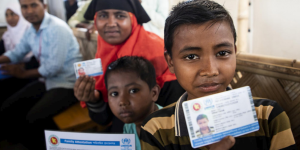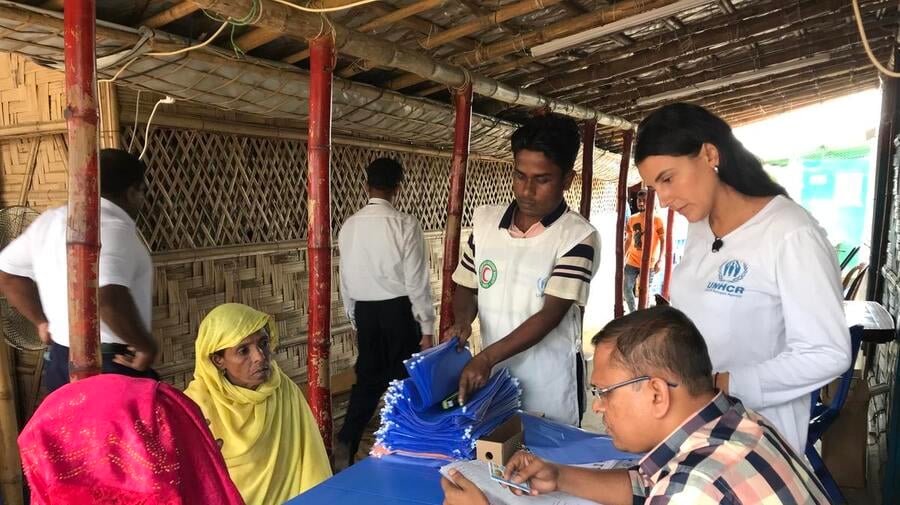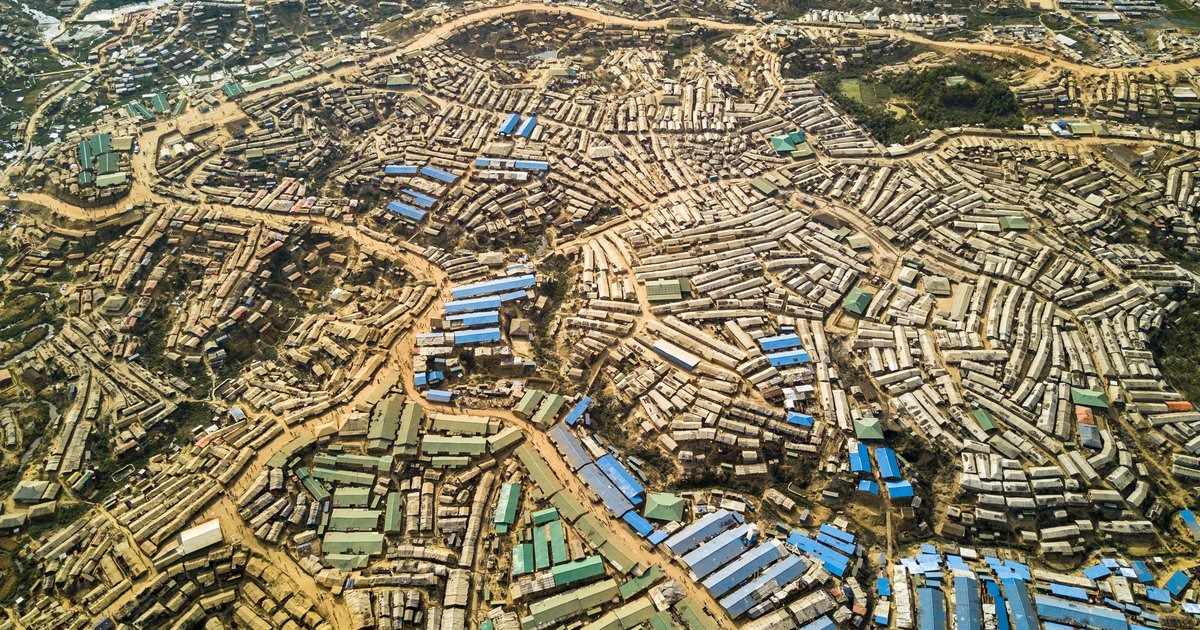From Camps to Forms: The Rohingya and Bangladesh’s Bureaucratic Embrace

Eight years after the Rohingya refugee influx began, Cox’s Bazar no longer runs on tents, convoys, and announcements alone. It runs on hoards of files, on renewal forms, on database lookups, on cards that must match the name on a server. Behind every movement of rice, every clinic visit, every shift in camp population, there is a form, an ID, a scan. Where there were once loudspeakers and tarpaulin, there are now terminals and spreadsheets. The language of accounting has slowly replaced the language of crisis. People are verified, re-verified, and listed again, not because repatriation is happening, but because administration has become the way to live with a crisis that will not end. Out of that repetition, something new has appeared—not return, not resolution, but a kind of settlement built out of procedure itself.
Registration as a civic habit
Registration is the skeleton of that settlement. Since 2017, the joint Government of Bangladesh–UNHCR biometric system has catalogued almost every Rohingya household in Cox’s Bazar. The initial purpose was straightforward: to identify who is in the camps so that assistance can be distributed fairly and any future repatriation list can be accurate. But once a population is fully entered, the database stops being just an aid tool and starts becoming a civic habit. Every transaction—ration pickup, clinic visit, education stipend, even relocation to another camp block—requires presenting a number, a photo, a set of fingerprints tied to a family. On paper, this keeps refugees separate from Bangladeshi nationals. In practice, it teaches everyone to follow the same routine: line up, present a card, receive a service, and move on. The registry doesn’t only count people; it standardises behaviour. After nine years, registration is no longer an “exercise.” It is a kind of civic training, conducted daily, without anyone calling it that.

The shared grammar of paperwork
The 2025 move by Bangladesh’s Election Commission to get access to the refugee database made this even clearer. Dhaka said it needed the data to block forged national IDs and to make sure Rohingya do not leak into the voter list. UNHCR agreed in principle in March; by August, the Commission was still pushing for full technical access. On the surface, this was bureaucratic housekeeping. Underneath it was something more interesting: the state learning to define itself against the camp, and the camp learning, through repetition, exactly how the state organises people. For refugees, knowing which office controls which list, which document they must never be found with, and which card they must always carry has become part of daily literacy. Paperwork is now the shared grammar of life on both sides of the fen when two groups submit to the same logic of documentation—even if for different purposes—they begin to resemble each other in practice, if not in law.
The quiet economics of forgery
Crackdowns sit inside this same logic. Police in Ukhiya and Teknaf periodically conduct sweeps for false NIDs and passports, and each sweep generates headlines about infiltration, security, and the need to “tighten monitoring.” In 2025 alone, only a few such cases surfaced in public: anti-corruption officials in Cox’s Bazar filed charges against five people for helping a Rohingya woman obtain a Bangladeshi passport; two women were detained at the Chandpur passport office after staff detected forged NIDs; and in January, another pair was arrested in Cox’s Bazar for trying to use other citizens’ birth certificates. Each case was treated as a national security alert. Yet people do not risk buying or forging IDs for sport; they do it because an ID is how you exist in Bangladesh. To claim a card, even improperly, is to claim a place. The state reads these incidents as breaches; a sociologist would read them as attempts at civic inclusion. And the paradox holds: the more thoroughly the government enforces the boundary, the more the people it governs internalise its methods—learning which documents to produce, which offices to navigate, and how the system defines belonging. Only a handful of document cases ever make it into headlines; no one really knows the full extent of the forgery, or how many names now move quietly through the same administrative grid meant to keep them out.

Services that cross the fence
At the same time, services have become increasingly integrated into a single operational field. Health posts, WASH networks, drainage projects, and even the municipal recycling plant no longer feel like temporary humanitarian add-ons; they feel like district infrastructure. Host-side contractors repair pipes that run through camps; refugee labour clears canals after heavy rain; engineers hired under development finance supervise both. The Health Sector’s own “Protracted Grade 2 Emergency” label is essentially an acknowledgment that this is now a permanent public system, not an emergency surge.
Registers and cards once marked only by the UN still carry the state logo; in many cases today, local municipality seals or donor-agency marks appear beside the original humanitarian insignia. Infrastructure is shared first through budgets, then through habit. When a hospital nurse in Ukhiya treats patients from both the host community and the camps, because the clinic serves the entire catchment area, the distinction between “refugee service” and “local service” collapses long before any policy suggests it has done so. That is how administrative coexistence starts—quietly, at the service counter.

Data and the new retail border
The digital economy inside the camps reinforces this convergence. A Rohingya household is registered biometrically and given an assistance account. WFP or another agency deposits a monthly entitlement—cash-equivalent credit—into that account. The family then taps an e-voucher card at a registered retailer, often a shop supplied by or linked to host-side traders. The point-of-sale device checks the card against the central database: Is this household active? Is there a balance left? Is this the correct camp code? Only then is the transaction approved. Instantly, a data trace is created: which household bought what, for how much, at which shop, on which day. For NGOs, this is about financial transparency and a way to demonstrate to donors that the money has reached real people. For the local bazaar, it is guaranteed demand—because the cardholders must spend locally where the devices are located. Host-side shopkeepers have adopted the same POS devices to capture this voucher traffic. Thus, the technology intended to ring-fence assistance has become the conduit through which camp spending is channeled into the host economy. In Cox’s Bazar, the practical metric of belonging is not the passport; it is the receipt. A unified retail logic—encompassing barcodes, digital wallets, and micro-commissions—has quietly replaced the visible border.

Containment and its side effects
Dhaka’s containment line feeds this process instead of stopping it. When the interim government leader stated in August 2025 that Bangladesh had “no scope for further allocation” for the 1.3 million refugees, he was making a strategic point: the state would supervise, but donors would have to pay. Supervision at that scale is labour-intensive. It requires thousands of local hires—engineers, teachers, enumerators, translators, health workers, security staff—who move back and forth between host areas and camps. Every time such a job is created, interdependence deepens. In an effort to preserve distinctions, the bureaucracy develops a shared workforce. Assimilation becomes an unintended administrative side effect: not planned, never announced, yet steady and hard to reverse.

The children of the ledger
Roughly half the Rohingya population in Bangladesh is under 18. They have never seen Rakhine State, but they speak Bangla with the rhythm of Cox’s Bazar, pick up local slang, follow Bangladeshi social media, and show up in learning centres that use versions of the national curriculum. UNICEF centres, informal madrasas, and phone-based lessons together create an educational environment that is more Bangladeshi than exilic. Their parents remain frozen in the registry as refugees from Myanmar; the children live in the culture of coastal Bangladesh. Identity becomes temporal: one generation recorded, the next absorbed. By 2030, the database may still mark them as refugees for targeting and rationing, but the town they grew up in will not see them as temporary.

Registration for residency
Repatriation remains theoretical. On paper, Myanmar cleared around 180,000 names for return earlier in 2025. In reality, no buses are left. What did move were the coordination meetings that set health targets, waste removal schedules, and procurement for small public works months in advance. The operation that began as emergency logistics now mirrors a district ministry—same cadence, same paperwork, same expectation that it will still be there next year. Lists move; people don’t. But through those lists, two societies—host and camp—have fused into one functional organism. The bureaucracy that was built to preserve separation has become the architecture of quiet assimilation. There will be no declaration, no law, no ceremony. It will happen as it is already happening—inside ledgers, beneath logos, between signatures. What began as registration has turned into residency.






















